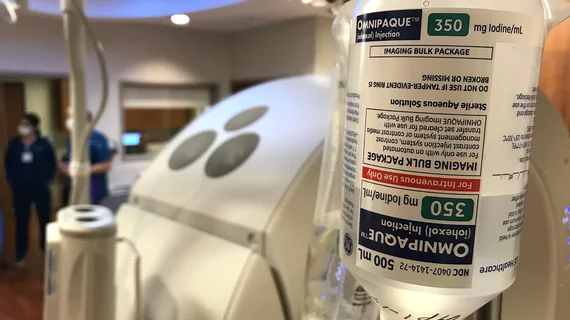New data suggest clinicians should think twice before foregoing contrast-enhanced imaging
Although contrast conservation efforts have been widespread across the imaging community since the ICM shortage of 2022 took hold, new data suggest that foregoing contrasted studies in favor of unenhanced imaging could be consequential for patients.
Published in JAMA Surgery, the new data highlight a potential pitfall of unenhanced CT scans on patients presenting to emergency departments with acute abdominal pain—an inaccurate workup. In these cases, foregoing contrasted CT exams can reduce diagnostic accuracy by up to 30%, authors of the new paper revealed.
“In a general population of emergency department patients with abdominal pain, using unenhanced CT to avoid risks of intravenous contrast medium administration was associated with a large diagnostic penalty,” study co-author Hiram Shaish, MD, with the Department of Radiology at Columbia University in New York, and colleagues explained.
For the study, the team analyzed the cases of 201 consecutive adult ED patients who underwent dual-energy contrast-enhanced CT for the evaluation of acute abdominal pain. Three blinded radiologists read the enhanced exams to establish a reference standard by majority rule. The team then used dual energy techniques to digitally subtract the contrast media from those same exams, which were subsequently interpreted by six different blinded radiologists (three specialist faculty and three residents).
Overall accuracy of the unenhanced exams was recorded as 70%, with the faculty achieving slightly higher scores for primary diagnoses. However, for actionable secondary diagnoses, residents recorded slightly better accuracy. This was because faculty made fewer false negative primary diagnoses, but more false positive secondary diagnoses, the team noted. Both false negative and false positive diagnoses were common with the unenhanced exams.
The use of contrasted imaging has to be weighed carefully both from an operational standpoint and within the realm of patient care as well, as ICM use carries risks of allergic reactions, hypersensitivity and kidney injury. However, there is no mistaking the diagnostic benefits associated with contrast-enhanced imaging, the team suggested, later adding that providers must strike a balance between these benefits and risks, especially in patients who are more vulnerable to adverse events or reactions.
The study abstract is available here.

